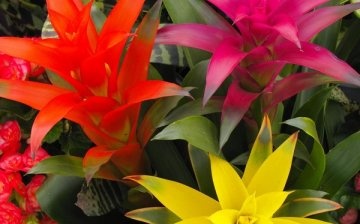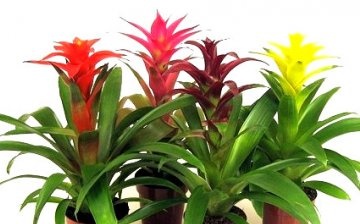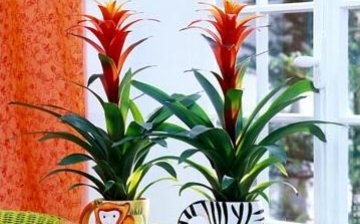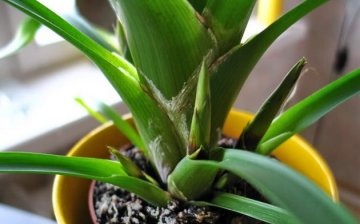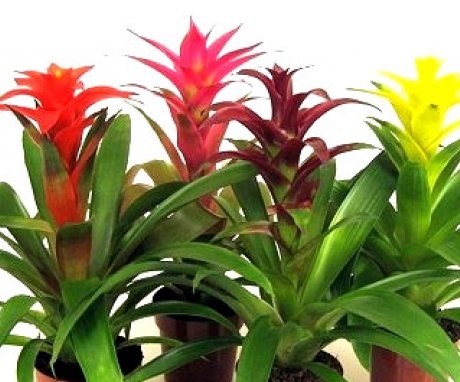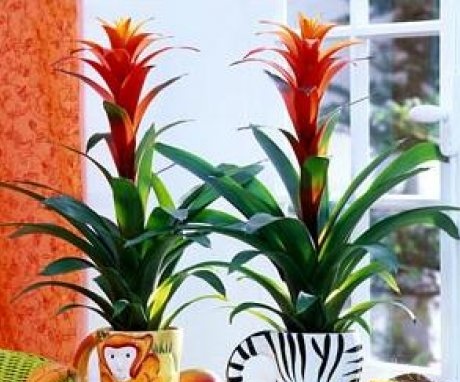Indoor flower guzmania: care, reproduction, general information
This exotic beautiful flower of the Bromeliad family has conquered many flower growers. Outwardly, guzmania is a bunch of dense leaves, similar to a fountain, from the center of which the same leaves grow, but red, yellow or orange.
Content:
General information about Guzmania
The original name of the flower is gusmania in honor of the biologist Guzman. South America is considered the birthplace of this flower. In the natural environment, guzmania takes root not into the ground, but into the rotten bark of trees. For this reason, the roots of Guzmania are very poorly developed, this must be taken into account when planting.
At the moment, in the wild, guzmania grows in India, Brazil, South and Central America. Since these places are quite arid, the bowl-shaped leaves of this plant allow it to stock up on water, which exotic birds often use.
Some information about the plant:
- At first glance, it may seem that such a warm and light-loving tropical plant will not take root well in our homes, that it will not be comfortable here and it is quite picky enough. But this is not at all the case.
- It is not so difficult to grow a guzmania indoor flower, it is enough to follow a few rules. With proper care, this flower will decorate your home with its flowers for more than one month.
- The leaves of this plant can be up to 70 cm long, depending on the species.
- After the guzmania fades, the mother plant dries up, but the "children" live on.
- Guzmania blooms for a long time, more than 3 months. Those bright flowers that you can see are actually inflorescences. Guzmania flowers are small and rather inconspicuous.
It is believed that the presence of guzmania at home allows the owner to become more generous, develop a strong character, and also free his home from prejudices and bad energy. Also, this beautiful flower is able to effectively purify the air. It is good to put it in offices, offices, where there are several people at once.
The peaceful energy of Guzmania will contribute to the resolution of conflicts, calmness, and protect against stress and depression.
Guzmania has a huge number of species. The most common: reed, mosaic, blood red, one-spiked, Donnell-Smith. Florists are especially fond of reed and blood-red guzmania.
Care features
Guzmania is epiphytic annual plant... This means that it dies after flowering and takes moisture mainly from the air due to a poorly developed root system. All this is important to consider when caring for a flower.
Although the guzmania is relatively unpretentious, in order to prolong its flowering, you need to follow some care rules. It blooms in spring and summer for several months, depending on the variety and species.
Care Tips:
- Tropical guzmania does not particularly like light and does not really need it, because it originally grew in the shade of trees. But for the most vibrant colors, place the guzmania under diffused sunlight. Direct rays can burn the leaves. You can keep the guzmania in the shade, but not on the windowsill. In summer, the sun will damage its leaves, and in winter, a scorching battery will finish off the plant with drought.
- No need to think that if this tropical plantthen it loves heat.The temperature in summer should be a little over 20 degrees, and a little less in winter. Then the guzmania will feel great. But too low a temperature is undesirable. Cold is not always harmful, but it can cause delayed flowering and various diseases.
- Guzmania loves high humidity. It needs to be sprayed as often as the temperature is high. In the summer, you can do this twice a day. You can also humidify the air in winter when the heating is on with the help of special humidifiers. They will delight both flowers and people with their coolness. Leaving water in the pan is also not prohibited, but it should not stagnate, otherwise the root will begin to rot. If you just sprayed the flower, do not expose it to the sun, otherwise the burns on the leaves will be even worse.
- Watering the guzmania in the standard way, through the soil, is not recommended, since this flower is not used to taking moisture from the ground. Occasionally and very carefully, you can moisten the soil, but it is better to prefer the usual spraying for plants.
- Do not plant guzmania in a large pot. An abundance of soil is unnecessary for her for the same reason, a poorly developed root. But the drainage must be good so that excess moisture does not stagnate.
- During flowering guzmania need to be fed mineral and organic fertilizers. To save time and effort, buy a ready-made solution for feeding bromeliads. Fertilize preferably once every 2-3 weeks. If you forget the last time you fertilized the soil, create a schedule that will prevent you from being late or overdoing it.
Reproduction and transplantation of guzmania
You only need to transplant guzmania if the pot and soil with which you purchased it do not match the flower. Usually the seller warns about this. If all is well, the pot is of a normal size, the soil is of the proper composition, there is no need to replant the plant immediately after purchase. Wait until spring, until the guzmania outgrows the box and the daughter shoots begin to bud.
Guzmania is transplanted in the same way as other flowers. It is necessary to slightly moisten the soil, carefully pull out the flower so as not to damage the root system and plant it in another pot with pre-prepared soil. Be sure to place drain stones at the bottom of the shallow pot. When the transplant is complete, the soil and leaves need to be watered.
If you are replanting a flower into new soil purchased from a specialty store, then you do not need to fertilize it for a month and a half.
On average, guzmania lives 1-2 years before flowering and six months after. But if you bought an already blooming guzmania (ask the seller how much it blooms already), it will live from six months to a year, and then we will be able to plant "children".
After the guzmania fades, it dries up, giving life to the shoots. However, this is not always the case. There are times when the mother plant does not die off. It will continue to grow if the "children" are planted. The offshoots can be grown without separating from the main flower, but can also be separated when they have their roots. This must be closely monitored, carefully digging in the soil under the shoots. In no case do not separate them before the root system appears, they will not be able to take root.
If you crave the appearance of "children", but the guzmania does not bloom, although it is high time, you can speed up this process.
For the flower to bloom, the surrounding air must be saturated with acetylene. This substance is secreted in sufficient quantities by rotting apples. Place the rotting fruit next to the flower and cover with plastic.
As a rule, guzmania gives only one shoot. When it gives its roots, it grows about 15 cm, and its leaves begin to dry out, it's time to plant. The process is separated with a sharp knife very carefully, without damaging the roots. The pot for the new guzmania should be small. Do not forget to put drainage on the bottom so that the plant does not die from excessive moisture.
More information can be found in the video.



